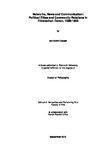Networks, News and Communication: Political Elites and Community Relations in Elizabethan Devon, 1588-1603
| dc.contributor.supervisor | Daybell, James R T | |
| dc.contributor.author | Cooper, Ian David | |
| dc.contributor.other | Faculty of Arts, Humanities and Business | en_US |
| dc.date.accessioned | 2013-05-21T09:55:13Z | |
| dc.date.available | 2013-05-21T09:55:13Z | |
| dc.date.issued | 2013 | |
| dc.identifier | 210915 | en_US |
| dc.identifier.uri | http://hdl.handle.net/10026.1/1469 | |
| dc.description.abstract |
Focusing on the ‘second reign’ of Queen Elizabeth I (1588-1603), this thesis constitutes the first significant socio-political examination of Elizabethan Devon – a geographically peripheral county, yet strategically central in matters pertaining to national defence and security. A complex web of personal associations and informal alliances underpinned politics and governance in Tudor England; but whereas a great deal is now understood about relations between both the political elite and the organs of government at the centre of affairs, many questions still remain unanswered about how networks of political actors functioned at a provincial and neighbourhood level, and how these networks kept in touch with one another, central government and the court. Consequently, this study is primarily concerned with power and communication. In particular, it investigates and models the interconnected networks of government within late-Elizabethan Devon and explains precisely how the county’s officials (at every level) shared information with the Crown and each other. The raison d’être of this study is, therefore, to probe the character and articulation of the power geometries at the south-western fringe of Elizabethan England. The closing years of the reign of Queen Elizabeth I represent a decisive phase in the evolution of the English nation state, one that saw the appointment of lord lieutenants on a more widespread and long-standing basis, the consistent training of certain sections of the county militias, the expansion of the pre-existing government post-stage service, a heightened degree of dealings between every echelon of administration and an obvious increase in the amount of information that flowed from the localities into the capital. The primary causes of each of these developments were the Elizabethan war with Spain (1585-1604) and the rebellion in Ireland (1594-1603), and it is demonstrated throughout this thesis that Devon, a strategically essential county during this period of political turmoil, provides an excellent case study for evaluating the impact that each had on the Crown’s ability to control the periphery whilst being spatially anchored at the court. Furthermore, by examining each of these developments the thesis fundamentally undercuts the tenacious assertion that geographically marginal regions of Tudor territory were inward-looking, remote and disconnected from events that were unfolding on a national and international level. | en_US |
| dc.language.iso | en | en_US |
| dc.publisher | University of Plymouth | en_US |
| dc.subject | Communication | en_US |
| dc.subject | Government | |
| dc.subject | Letter-writing | |
| dc.subject | News | |
| dc.subject | Politics | |
| dc.subject | Tudor | |
| dc.subject | Elizabethan | |
| dc.subject | Devon | |
| dc.title | Networks, News and Communication: Political Elites and Community Relations in Elizabethan Devon, 1588-1603 | en_US |
| dc.type | Thesis | |
| plymouth.version | Full version | en_US |
| dc.identifier.doi | http://dx.doi.org/10.24382/3631 |
Files in this item
This item appears in the following Collection(s)
-
01 Research Theses Main Collection
Research Theses Main


